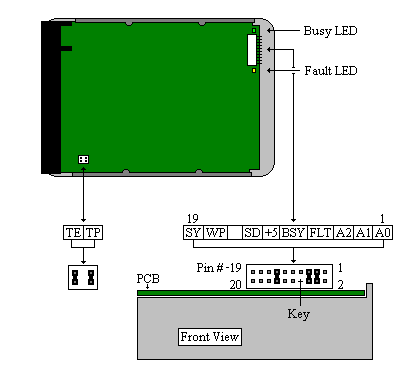
Interface
Fast SCSI-2 50-pin Connector
Fast Wide Single Ended SCSI-2 68-Pin Connector
Fast Wide Differential SCSI-2 68-Pin Connector
Fast Wide Single Ended SCSI-2 80-Pin SCA
Unformatted Capacity (MB) 2,689
Formatted Capacity (MB) 2,150
Disks 5 Heads/Recording Surfaces 10 Tracks per Surface 3,832 Sectors per Track 80 to 134 Bytes per Sector 512 Track Density (tpi) 3,858 Recording Density (bpi) 81,765 Encoding Method RLL (1,7)
Typical Seek Times (ms)
Average Seek 8.5
Track-to-Track 1.0
Full Stroke <18
Rotational Speed (RPM) 7,200
Average Rotational Latency (ms) 4.17
Internal Data Rate (Mb/sec) 49.1 to 82.1
Net Host User Data Rate (MB/sec) 4.9 to 8.2
Data Transfer Rates (Buffer-to-Host)
Fast SCSI-2 (MB/sec) 10
Fast Wide SCSI-2 (MB/sec) 20
Buffer Size (KB) 1,024
Projected Field MTBF (hours) 800,000
Preventative Maintenance Not Required
Data Errors (bits per read)
Recoverable <1 in 10^11
Nonrecoverable <1 in 10^15
Error Correction Method Reed Solomon
Warranty (years) 5
Dimensions in inches (mm)
Width 4.0 (101)
Length 5.75 (146)
Height 1.0 (25.4)
Weight in pounds (kg) 1.21 (0.55)
Operating
Temperature (°C) 5 to 55
Non-Condensing Humidity (%) 10 to 90
Shock (G, 10ms) 0.5
Vibration (G, 22Hz to 400Hz) 0.5
Typical Audible Noise 34
(dBA @ 1 m, any direction, idle)
Non-Operating
Temperature (°C) -40 to 66
Non-Condensing Humidity (%) 5 to 95
Power Requirements
+5V DC ±5% (A, typ) 0.6
+12V DC ±5% (A, typ) 0.6
Power Draw (W)
Idle 9.0
Seek (40 percent) 10.2
Jumper Name Description
TE - Termination enabled
TP - Termination power
Pins 1-2 A0 SCSI ID address selection
Pins 3-4 A1
Pins 5-6 A2
Pin 7 FLT Out Fault display LED option
Pin 9 BSY Out Busy display LED option
Pin 11 +5VDC LED anode connection
Pin 13 SD Spin delay option
Pin 15 - Reserved - not used
Pin 17 WP Write Protect option
Pin 19 SY Spindle Sync.
Table 1
Termination Enable (TE)
One of the requirements of the SCSI bus is that it be properly terminated. If more than one SCSI device is connected to the host, only the last device must be terminated. The Terminator Enable (TE) jumper, when installed, enables an active termination circuit, thereby terminating the SCSI bus. With the TE jumper removed, bus termination is disabled.
At the factory, Quantum configures the Atlas XP32150/34300S hard disk drive with termination enabled; that is, with a jumper installed across the termination pins on jumper block J5. To disable termination, remove the jumper from the pins at location J5. [Refer to figure 1 for jumper location.]
Note: There are no Termination Resistor Packs to remove on this drive.
Termination Power (TP)
It is recommended that the drive be configured to provide Termination Power to the SCSI bus. This ensures that there is sufficient power along the entire SCSI bus. The Termination Power (TP) jumper, when installed, enables termination power to be provided by the disk drive.
At the factory, Quantum configures the Atlas XP32150/34300S hard disk drive with termination power enabled; that is, with a jumper installed across the termination power pins on jumper block J5. To disable termination power, remove the jumper from the pins at location J5. [Refer to figure 1 for jumper location.]
SCSI-Bus Device Identification
Used in combination, the jumper settings across reference pins of the Option Connector J3 determine the Atlas XP32150/34300S hard disk drive's SCSI-bus device I.D.
To assign a different SCSI ID, change the jumper settings as shown in Table 2.
Pins 5-6 Pins 3-4 Pins 1-2 SCSI ID OFF OFF OFF 0 OFF OFF ON 1 OFF ON OFF 2 OFF ON ON 3 ON OFF OFF 4 ON OFF ON 5 ON ON OFF 6 ON ON ON 7 Table 2
Spin Delay (SD)
With the Spin Delay jumper installed, across pins 14-15 of Option Connector J-3, the drive will start power up sequence immediately when power is applied. With the Spin Delay jumper removed the drive will power up when a START/STOP command is issued by the host adapter.
By default, Quantum configures the drive with a jumper installed across pins 14-15.
Spindle Sync (SY)
Atlas disk drives support synchronized spindle operation. Master or slave synchronized operation is set through a SCSI Mode Select Page.
When the drive operates as a Master drive, it generates a spindle synchronization reference signal, SPINDL_SYNC_REF L. When operating as a slave, the drive synchronizes its spindle according to the SPINDL_SYNC_REF L input reference. The drive always maintains local speed regulation when no reference signal is applied.
Pin 19, of Option Connector J-3, is provided to facilitate installations where a 2-pin connector for SPINDL_SYNC_REF L will be used. For Atlas drives, pin 10 is provided as an alternate connection to facilitate installations where a 10-pin header is used to connect several remote features. The ground return is pin 20, although pins 2, 4, or 6 can be used for ground return.
Write Protect (WP)
To enable write protection on the drive, install the referenced jumper across pin pair 17-18 of Option Connector J-3. To disable write protection from the drive, remove the jumper from pin pair 17-18.
Remote LED Status Display
Busy and Fault status for Atlas XP32150/34300S disk drives can be monitored remotely by connecting a remote Busy and a remote Fault display LED to the drive's Option Connector J-3.
Busy status is monitored remotely by connecting the cathode side of the remote Busy LED to the BSY_OUT L pin. The anode side of the LED connects to the +5 VDC OUT pin.
Fault status is monitored remotely by connecting the cathode side of the remote Fault LED to the FLT_OUT L pin. The anode side of the LED connects to the +5 VDC OUT pin.
